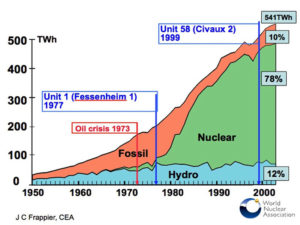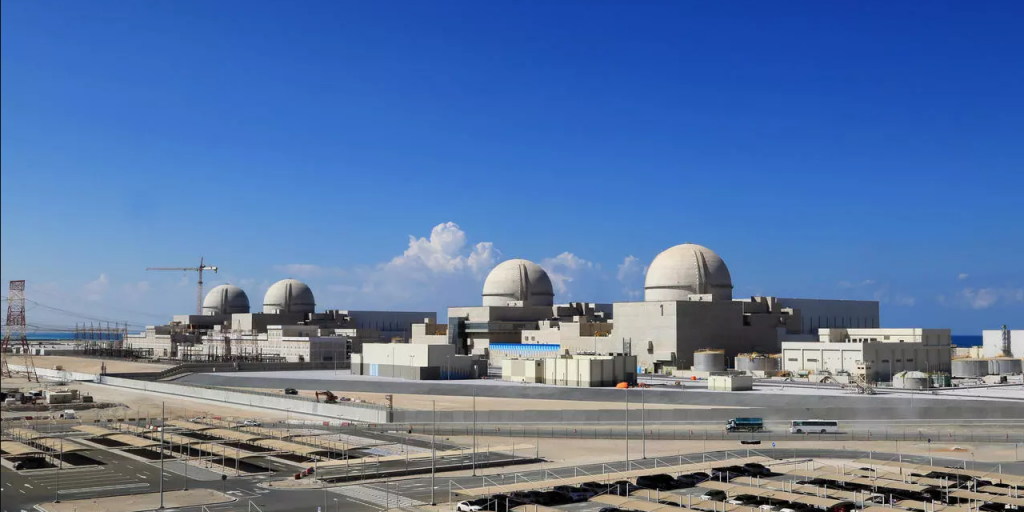
How Many Nuclear Plants?
In a 22 year period from 1977 to 1999 France built a generating system containing 58 reactors.
Its capacity was of similar size to Australia’s but generates only 40 gr CO2/kwh or less that a 20th of Australia’s emissions intensity.
Edition 4, Revised 12/12/2021
How many nuclear power plants are required to meet the needs of the National Electricity Market (NEM) in 2042?
The annual energy demand from grid based generators is projected by AEMO to be of the order of 228 Terrawatt hours per year.
To meet this demand our analysis shown here in The Economics of Nuclear requires 24.7GW of installed nuclear capacity.
The NEM is capable of replacing all coal and gas plants with new nuclear power plants and only very minor transmission adjustments would be needed.
This can be achieved through two routes:
- The faster route would use a combination of existing large nuclear power plants such as twelve South Korean APR 1400 units combined with twenty seven General Electric BWRX 300 small nuclear power plants. We’ll call this the “Mixed” route
- The slower route which is reliant on the BWRX 300 plant being first commissioned in Ontario would see eighty eight small nuclear plants built in groups at the nodes of the grid. We’ll call this the “SMR” route.
State by State breakdown
In the remainder of this section we will provide a “broad brush” scoping of the size of the project. The initial sites would utilise existing coal and gas generating sites.
1. New South Wales and ACT
Within New South Wales we have about 10 GW current coal plant capacity variously commissioned between 1973 and 1993. These plants which include Liddell, Vales Point B and Eraring produce about 73 million tonnes of CO2 per annum and carbon intensities of approximately 1,000 gr. CO2/kWh.
In addition we have 2 GW of younger peaking gas plants with emissions of up to 730 gr. CO2/kWh. We also have potential generating sites at disused plants such as Wallerawang and Munmorah where 2.4GW of capacity was previously in operation.
The new nuclear capacity in each state is proportioned approximately to the percentage of energy currently generated in each state.
Therefore, in NSW the two routes would see:
- Mixed Route – six APR 1400 large plants and seven BWRX 300 small plants
- SMR route – thirty two BWRX 300 small nuclear power plants
2. Victoria
Within Victoria we have 6.3 GW of current brown coal plant capacity commissioned between 1964 and 1985. These plants are Hazelwood, Loy Yang A&B and Yallourn and include some of the world’s most polluting generators with up to 1,400 gr. CO2/kWh. In addition another 2.4 GW of gas power exists which was commissioned between 1979 and 2012.
Based on Victoria’s proportion of generation the two routes would see:
- Mixed Route – four APR 1400 large plants and six BWRX 300 small plants
- SMR route – twenty two BWRX 300 small nuclear power plants
3. Queensland
In Queensland about 8.4 GW of coal generators are operating. These were commissioned between 1968 with Callide B and 2007 with Kogan Creek. In addition another 3.5 GW of gas power capacity was constructed between1960 with Mica Creek but the rest after 1999.
Based on Queensland’s proportion of generation the two routes would see:
- Mixed Route – two APR 1400 large plants and eleven BWRX 300 small plants
- SMR route – twenty eight BWRX 300 small nuclear power plants
4. South Australia
Within South Australia the coal plants are closing down though 2.7 GW of gas power exists which maintains high greenhouse gas emissions. In 2014 South Australia produced 7,600 GWh of fossil fueled generation.
Based on South Australia’s proportion of generation the two routes would see:
- Mixed Route – four BWRX 300 small nuclear power plants
- SMR route – six BWRX 300 small nuclear power plants
5. Western Australia
Within Western Australia there are three electricity generating systems and they are not connected together.
The largest is the South West Interconnected System (SWIS) which has some 2.994GW of capacity and 91% of this is powered by fossil fuels.
The North West Interconnected System (NWIS) has 554MW of generating capacity but this can change rapidly because being located in the Pilbarra region it responds to changes in resource development. The NWIS is closer to 99% fossil fuel dependent.
The major challenge for decarbonisation in WA are the Non-Interconnected generators which total 3,390MW of capacity and are 99% fossil fueled. They consist of many small generators located around the state at small communities and resource projects and are often separated by hundreds of kilometres.
If only the current demand of 20.2TWh/year and 2.994GW of fossil capacity was met by small nuclear power plants, then with small nuclear power plants meeting the 76% of the load then seven BWRX 300 small nuclear power plants would be required.
6. Tasmania
Tasmania is currently supplied by hydropower
The State currently generates about 6% of the NEM and this is almost exclusively from Hydro and wind. About 10% is imported which equates to about 1.2TWh/ year. At this stage it is considered that no new small nuclear power plants would be constructed in the state. Low carbon nuclear energy could be imported from Victoria via links across Bass Straight.
7. Northern Territory
The Northern Territory is currently supplied by 618.2MW of gas fired power
Reference to the future demand in the Northern Territory in the BREE 2014 document shows that by 2050 the state will require 7 TWh of electricity per annum. Assuming 70% of this is provided by a reliable low carbon source such as nuclear energy then this equates to two BWRX 300 small nuclear power plants.
Transport Fuel
This resolution of this issue is of massive benefit to both Australia’s national security and our environment. As the steady replacement of the fleet of motor cars, motor cycles, light vehicles and buses with electric power takes place, the demand for additional electricity generation will increase rapidly.
In 2012 Australia consumed 215,570 mega litres of petroleum products in light vehicles, passenger cars and buses. In a 2013 report, Australia’s Fuel Security, commissioned by the NRMA found that Australia imports 91 per cent of its fuel, up from around 60 per cent in 2000.
Over a two or three decade period, in the eastern states alone, the replacement of some 200,000 mega litres per year of liquid fossil fuels costing around $32 billion at $1.4/litre could be replaced by electricity costing $8.5 billion at $150/MWh.
By 2050 if Australia used 80% of electrified light vehicles and 40% of heavy transport then this could be met by 8.3 GW of nuclear power plants on the NEM and 1.2GW SMR’s in Western Australia.
The potential also exists for increased use of electrified rail freight and high speed rail which would reduce air travel. This will further increase the need for reliable and despatchable electricity generation.
Primary Energy Processes
Stationary energy and industrial processes amount to 23% of Australia’s Greenhouse Gas emissions.
One very exciting process advocated by John Morgan through the Breakthrough Institute can be viewed at The Breakthrough Institute – Ammonia is Everest Base Camp for Clean Energy. This concept provides a clear direction to eliminating the emissions of carbon dioxide emissions in fertiliser manufacture and can be extended to all processes requiring hydrogen production and even transport fuels.
Some other processes such as cement and metal manufacture have unique process issues requiring high temperature process heat which may be provided by a future generation of high temperature reactors. Nonetheless increased electricity use within these sectors could displace large amounts of fossil fuel use though no estimate is included at this stage.
By 2050 the BREE report projects that Australia will consume some 1618Pj of primary energy. Assuming that 70% of this became electric power operating at 90% efficiency instead of around 35% from thermal source then this would require some 122.4TWh/annum which could be supplied by a further 15 GW of nuclear power plants on the NEM and 2.5GW of SMR’s in Western Australia .
Australia’s Reactor program to supply our needs in 2042
In summary then the roll out requires at least
27.1 GW of new nuclear power capacity to supply 76% of Australia’s electrical energy by 2042,
9.5 GW of nuclear power plants for the replacement of petroleum products in 80% of light vehicles and 40% of heavy transport,
at least 17.5 GW of nuclear power plants for 70% of industrial processes
This is a large program though comparable to that achieved in France over a 22 year period from the 1970’s to the 1990’s.
Further Development
This section of the project requires help in exploring the options and developing the concepts.
It requires people with skills in:
- Electrical Engineering to advise on grid assessment, scoping and costing
- People with skills in industrial and mechanical processes, chemistry, metallurgy to invent new electrified processes to maximise the use of electricity to displace fossil fuel use.
- Electrical demand projections including new markets and fossil fuel replacement strategies.
- Construction personnel both professional and trades related to help build up the costing and workplace opportunities.


